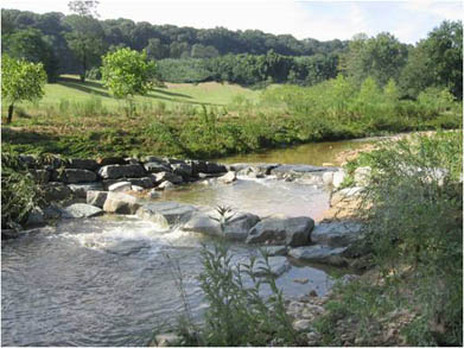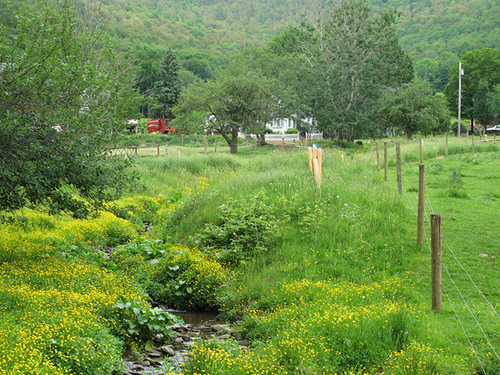Stream rehabilitation projects can help protect our streams from pollution and improve habitat both in and along the stream banks. Non-point source (NPS) pollution such as siltation from eroding banks and nitrates from fertilizer runoff and livestock negatively impacts wildlife and increases costs to treat our drinking water.
What does CCCD recommend to stabilize my eroding streambank and reduce NPS pollution?
Best management practices (BMPs) such as riparian buffers, stream bank fencing, and agricultural crossings are just some solutions we can utilize to help keep streams protected from non-point source pollution. Habitat structures for fish and other aquatic organisms also help to support stream ecosystems and wildlife populations, while stabilizing the stream channel. Curious about these structures? Check out this document to see the structures we can work with!
What can landowners do on their own property to help reduce flooding impacts throughout the county?
Healthy soils, establishing vegetation, and smart land development in the landscape are KEY to managing water! Check out this document for more information and suggestions.
DID YOU KNOW?? 1 mature deciduous tree can intercept 700-1,000 gallons of rain water annually! 1 mature evergreen tree can intercept >4,000 gallons of rain water annually!! That's a lot of stormwater we can prevent from reaching the streams and cause flooding.
Why aren't we dredging the creeks?
Unfortunately, dredging actually INCREASES flood damage both upstream and downstream from the site of concern. This document does a GREAT job explaining the long-term effects of dredging.
Do I need a permit for my project?
Check out this page for more information on permitting requirements!
What does CCCD recommend to stabilize my eroding streambank and reduce NPS pollution?
Best management practices (BMPs) such as riparian buffers, stream bank fencing, and agricultural crossings are just some solutions we can utilize to help keep streams protected from non-point source pollution. Habitat structures for fish and other aquatic organisms also help to support stream ecosystems and wildlife populations, while stabilizing the stream channel. Curious about these structures? Check out this document to see the structures we can work with!
What can landowners do on their own property to help reduce flooding impacts throughout the county?
Healthy soils, establishing vegetation, and smart land development in the landscape are KEY to managing water! Check out this document for more information and suggestions.
DID YOU KNOW?? 1 mature deciduous tree can intercept 700-1,000 gallons of rain water annually! 1 mature evergreen tree can intercept >4,000 gallons of rain water annually!! That's a lot of stormwater we can prevent from reaching the streams and cause flooding.
Why aren't we dredging the creeks?
Unfortunately, dredging actually INCREASES flood damage both upstream and downstream from the site of concern. This document does a GREAT job explaining the long-term effects of dredging.
Do I need a permit for my project?
Check out this page for more information on permitting requirements!
|
Streambank and stream structures
|
Streambank fencing
|
To schedule a site visit to your stream and to be added to our project list for potential grant funding, please contact our Watershed Specialist, Abby Frey, at (570) 317-9491 or [email protected]

